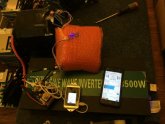OverkillSolar
Solar Enthusiast
- Joined
- Mar 26, 2020
- Messages
- 188
On the one I sell, The only header that’s populated is SW, it can be enabled from the apps and it functions as a discharge cut off switch. Could be useful to prevent discharging in storage or prevent unauthorized use, in the case of electric vehicles. I ordered the next batch with the 2 pin connector installed.Has anyone successfully mapped out what the other connections are on this JBD BMS? Apart from the comm and balance lead connections?
Looking from left to right on mine, I see:
- CANBUS?
- CANH
- CANL
- GND
- Mystery
- B
- A
- Mystery
- "SW" with 2 terminals
- Comm port - TTL? what baud?
- VDD
- TX
- RX
- GND
- Mystery
- Bat+
- NC
- Bat-
- Balance lead 4S
- BC4
- BC3
- BC2
- BC1
- BC0
The comm port is TTL 9600 baud. The protocol datasheet is on my github page.



